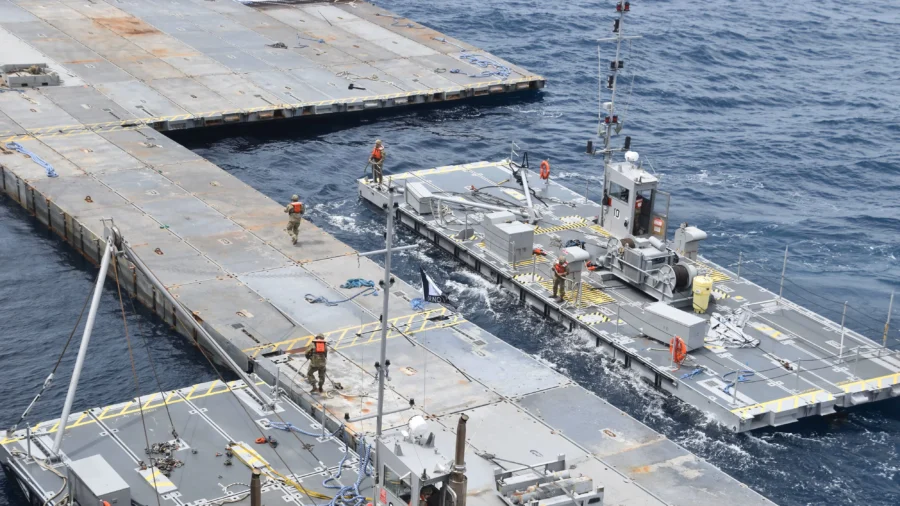The U.S. military-built pier designed to facilitate aid deliveries to the Gaza Strip has been repaired and reconnected to the Gazan shoreline after a section broke apart in a storm, the U.S. Central Command (CENTCOM) announced Friday.
The military effort to reconnect this makeshift pier—known as a Joint Logistics Over-The-Shore (JLOTS) system—to the Gazan shoreline comes nearly two weeks after rough seas beached four U.S. military vessels supporting the pier structure. The pier was initially attached to the shoreline on May 16, and began facilitating humanitarian traffic on May 17, before the storms rendered the pier inoperable on May 25.
The Pentagon announced on May 28 that U.S. military personnel had detached and hauled away the damaged pier to begin repairs at the southern coastal Israeli city of Ashdod.
“Earlier this morning in Gaza, U.S. forces successfully attached the temporary pier to the Gaza beach,” Vice Adml. Brad Cooper, deputy commander of U.S. Central Command, told reporters by phone on Friday, June 7. “We expect to resume delivery of humanitarian assistance from the sea in the coming days.”
CENTCOM Vows to Increase Supply Traffic After Repairs
Vice Adml. Cooper indicated the reconstructed JLOTS pier will also be able to facilitate an even greater degree of humanitarian supplies than it had before the storm damage last month.
During the original construction phase, the Pentagon indicated the JLOTS pier would be able to facilitate about 90 truckloads of food and other humanitarian supplies into Gaza on average every day once it begins operating, and then could expand to facilitate about 150 truckloads of supplies daily.
By the time the pier broke apart on May 25, after just eight days operating, the Pentagon reported around 1,000 metric tons of aid had transited the makeshift pier system.
Vice Adml. Cooper said Friday that, once the military can resume pier operations, they will ramp up delivery rates. He set a goal to soon have 1 million pounds of food and other supplies flowing across through the pier into the Gaza Strip every two days.
The U.S. military has used both the JLOTS pier and air-drops to facilitate increased humanitarian assistance to the embattled Gaza Strip, amid signs of a burgeoning famine.
U.S. Agency for International Development (USAID) Administrator Samantha Power testified during an April 10 House hearing that nearly the entire population of the Gaza Strip “is living under the threat of famine” and indicated famine conditions had likely already begun in some areas in the north. She based that assessment on a March report on the United Nation’s Integrated Food Security Phase Classification (IPC).
Ms. Power said at the time that while humanitarian supply deliveries through the Gaza land crossings had improved somewhat, “the destruction of greeneries, and markets, and arable land, and then the fact that so few trucks got in over so many months means we have massive catch-up to do.”
The United Nations has estimated about 500 truckloads of humanitarian supplies and private sector goods reached the Gaza Strip daily through land crossings before the start of the current conflict.
President Joe Biden announced a three-phase ceasefire proposal last week that would see an average of 600 truckloads of humanitarian supplies entering the Gaza Strip every day.
“With a ceasefire, that aid could be safely and effectively distributed to all who need it. Hundreds of thousands of temporary shelters, including housing units, would be delivered by the international community,” President Biden said. “All of that and more would begin immediately.”
Pentagon Lowers Pier Cost Estimate
Pentagon officials have previously estimated the JLOTS pier would cost around $320 million to reach its initial operational capacity.
Speaking with reporters on Wednesday, Deputy Pentagon Press Secretary Sabrina Singh revised cost estimates for the JLOTS pier down to just $230 million, citing “lower-than-expected costs for contracted trucks, drivers, and commercial vessels,” and the United Kingdom’s decision to contribute a vessel to support the humanitarian pier mission.
Ms. Singh said the new storm repair costs were factored into her revised estimate for the JLOTS mission, though she noted the cost estimates may continue to change.
“While assessments are ongoing, this assessment—this estimate does include some of the costs associated with the repairs and rebuilding of the pier,” she said. “And just as a reminder, these are estimates and initial assessments, and the cost could fluctuate depending on the length of the mission and future costs, an example of that being additional repairs.”
The Associated Press contributed to this article.

